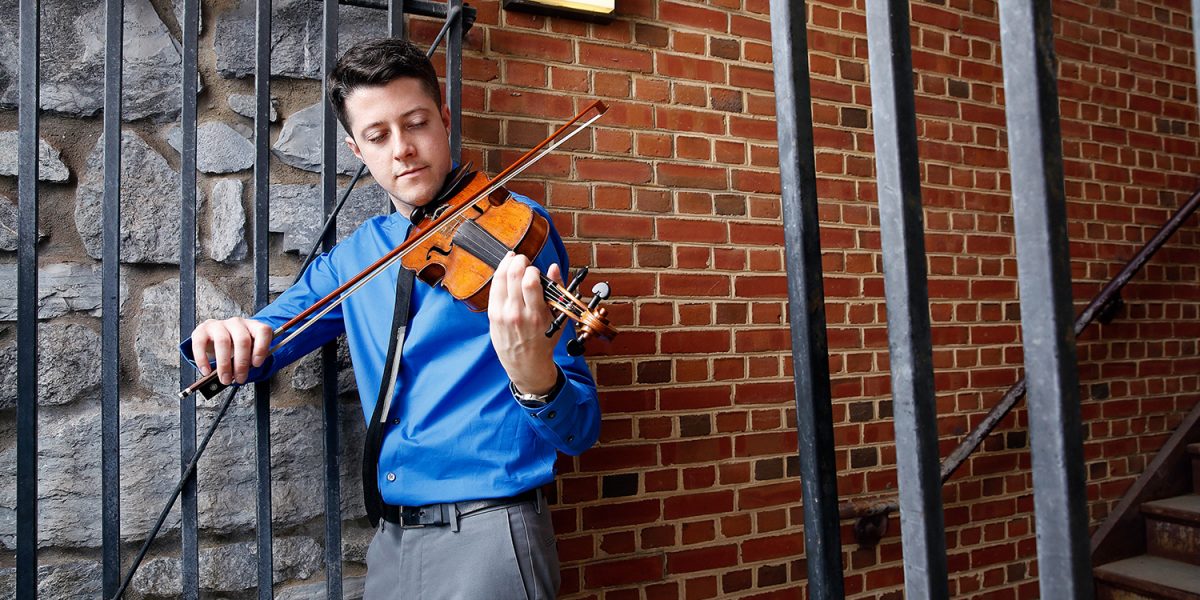Arts & Culture
A Bluegrass Legend Grows in Baltimore
Fiddle player Patrick McAvinue is taking the city’s musical traditions to the national stage.
For the past 15 years, Patrick McAvinue has been a rising star in the bluegrass world, first finding his string instrument at age six in Baltimore County before joining some of the region’s best string bands (see Smooth Kentucky, then Charm City Junction) and ultimately working his way to to the national stage and being named Fiddle Player of the Year by the International Bluegrass Music Association in 2017. In fact, fusing his traditional sound with a medley of other influences, many consider the virtuosic musician a sort of best-kept secret of Americana. Though he now resides in Nashville, where he’s a regular at the Grand Ole Opry, McAvinue can still often be found in Baltimore, which he continues to credit as his home. On the heels of the release of his third solo record, Perfect Fit, we caught up with the fiddler to talk about his musical upbringing and evolving his old-school genre outwards for the entire world.
What does Perfect Fit refer to?
It’s a culmination of all the things that have come together in my life up until this moment. All the people I’ve met and artists I’ve been able to work with. I’ve been on the road since I was a teenager. My first tour was with Audie Blaylock at age 16. Then in college at Towson University, where I studied music, I learned about Bach and Coltrane and all these different techniques that I would then try to play at bluegrass festivals. In Charm City Junction, we tried to explore each other’s music in ways that respected tradition while pushing boundaries to create something new. I got the call from [national bluegrass band] Dailey & Vincent in 2016, so I moved to Nashville. I bought a house and just got married. All of these things have formed me as a musician. I’ve learned so much. And these tunes are diverse, but somehow, they fit together.
Do you consider this a bluegrass record?
It’s an expansion. No matter what, I’m a bluegrass musician. That’s what I’ve done all my life. But the music has to evolve. Bluegrass is still alive, still growing, and it’s made up of so many amazing pastimes—Old-Time Appalachian music, Celtic and [British] Isles music, the Mississippi Delta blues. Even Bill Monroe, the father of bluegrass music, was just trying to form his own sound. I don’t want to be a torch-bearer, but I am by default because I’ve been playing this for a long, long time. The music I’m creating is music of the people . . . That’s something I want to champion for myself and for my own music students: keep your ears open and let the outside world influence what you do and how you create.
You discovered bluegrass at a young age, when so many other kids are fawning over electric guitar. What was it about the genre for you?
To me, it was electric. When you listen to Earl Scruggs’ banjo, it is as exciting as a Keith Richards or Eric Clapton guitar solo. It’s like Stevie Ray Vaughn music to me. It’s got that explosive power, and when I was a kid, that’s what I heard. But what really got me was when I was about six years old; I was at my friend’s house and his father yelled to him, ‘Hey Wills,’ grab your fiddle, let’s play something for Pat.’ They played the mandolin together and I thought, ‘I want to do that.’ From there, I went down a rabbit hole, then I went to college and studied music, and my interest exploded even more. It was coming into a consciousness. Your mind starts to expand, and you start getting a wider perspective of the world, and what your part is.
Speaking of the world, you include a number of other musical influences on this album outside of traditional bluegrass.
I spent a month in Ecuador on tour in 2012 and I got to work with these musicians and see how they feel rhythm in choro music. And at Towson University, my classical professors had a huge impact on me, too. I would listen to Bach, Debussy, Beethoven, even early Gregorian chant. I had a chance to study other worlds of music that are completely separated by culture and time and let them influence what I do. That was something I really wanted to champion for myself, and that I now want to champion for my own music students: keep your ears open and let the outside world influence what you do and how you create. It’s really important for me to be a broader part of the world community of music.
That being said, you’ve seen Baltimore’s music scene evolve so much over the last 15 years. Do you still find inspiration here?
I’m continually inspired by the artists and people who are creating in Baltimore and getting to see so many of my friends taking their own approach to music continues to influence me, too. The people of Baltimore are very open and appreciative of art and self-expression. They let you be you, and have a good time doing it. Those are traits I take with me everywhere I go. At the end of the day, even though I hang my hat in other places, Baltimore is my home and always will be.
